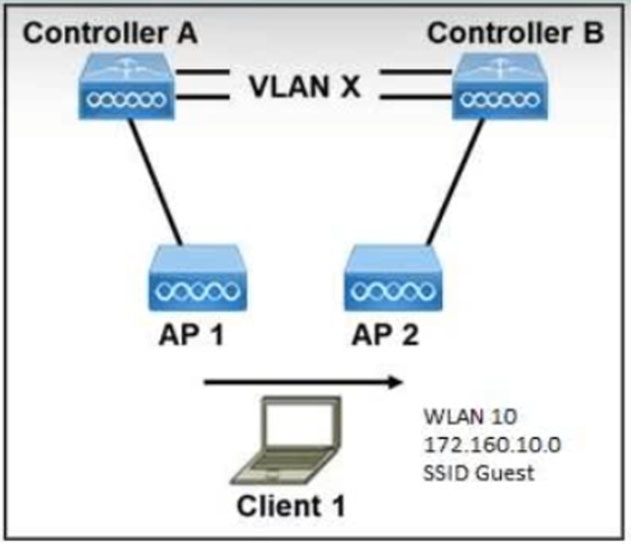
Refer to the exhibit. Both controllers are in the same mobility group. Which result occurs when client 1 roams between APs that are registered to different controllers in the same WLAN?

Refer to the exhibit. Both controllers are in the same mobility group. Which result occurs when client 1 roams between APs that are registered to different controllers in the same WLAN?
When a client roams between access points (APs) that are registered to different controllers within the same Wireless Local Area Network (WLAN) and mobility group, the client database entry is transferred from the original controller to the new controller. This process is known as Inter Controller-Layer 2 (Intercontroller-L2) Roaming. In this type of roaming, because both controllers have interfaces within the same client subnet, they exchange mobility control messages to update the client's database entry, enabling seamless connectivity for the roaming client.
This is called Inter Controller-L2 Roaming. Inter-Controller (normally layer 2) roaming occurs when a client roam between two APs registered to two different controllers, where each controller has an interface in the client subnet. In this instance, controllers exchange mobility control messages (over UDP port 16666) and the client database entry is moved from the original controller to the new controller.
A is correct, if this is Intercontroller Layer 2 Roaming (the client database entry is moved to the new controller). https://www.cisco.com/c/en/us/td/docs/wireless/controller/8-5/config-guide/b_cg85/overview.html
B. A CAPWAP tunnel is created between controller A and controller B. When a client roams between access points that are registered to different controllers in the same WLAN, a CAPWAP (Control And Provisioning of Wireless Access Points) tunnel is established between the controllers to allow for seamless roaming. This allows the client to maintain its connection without interruption as it moves between APs, and allows the controllers to keep track of the client's location and status in the network.
I agree with your reasoning and I also selected option B but not sure if I'm missing something as mostly everyone is going with A.
I could be wrong, but I think the CAPWAP tunnel has already been established before, because the controllers are in the same mobility group. It's not a result of a client roaming to a different controller. But it does cause the client database entry to move.
well, new CAPWAP tunnel is established as the old WLC will be anchor and new WLC will be foreign and by this roaming is seamless and the end device keeps its IPs and all traffic will be sent back to the anchor WLC
A is correct, https://www.cisco.com/c/en/us/td/docs/wireless/controller/8-2/config-guide/b_cg82/b_cg82_chapter_010011010.pdf
A is correct